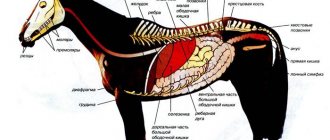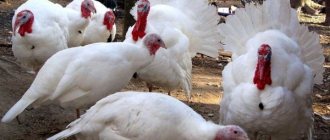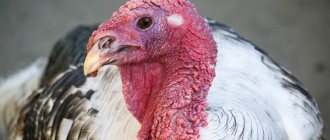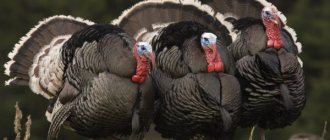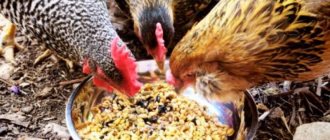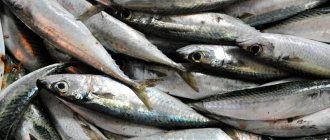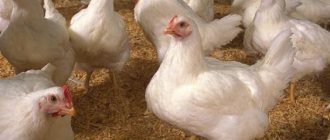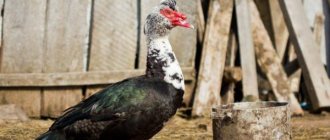Basic recommendations for turkey feeding
In general, the diet of turkeys is almost no different from the menu of ordinary chickens - the closest relatives of turkeys. But modern fast-growing crosses for full development require a balanced diet with high nutritional value and high protein content.
The basis of the bird's diet is grain feed; preference is given to corn, peas, wheat, and barley. These grains are easy to digest and provide a lot of energy for muscle and bone growth.
The turkeys are fed greens, vegetables, food waste, bran, cake and fusa, skimmed milk and whey. Products must be fresh, without signs of spoilage.
Turkeys are fed dry feed or wet mash several times a day. They make sure that their residents always have clean water in their premises.
What to do if birds are not gaining weight
In most cases, turkeys do not gain weight due to illness, so it is recommended to examine them first and, if necessary, treat them.
If the disease was not detected, the reason lies in poor nutrition and care.
Then it is necessary to carry out the following activities:
- increase feeding frequency up to 4 times a day;
- supplement the diet with green feed and mash;
- control that the bird eats at least 0.8 kg of feed daily;
- prevent overflow of turkey crops;
- observe the temperature regime in the enclosure;
- regularly ventilate the enclosure, releasing clean and fresh air;
- include a vitamin-mineral complex in your diet.
If all the rules are followed and the turkeys are in normal health, the birds will begin to gain weight in a short time.
What to feed turkeys
Complete feed for turkeys, balanced in composition, can be purchased ready-made in a store or ordered at a feed mill. There are 4 gradations of composition, depending on the age of the bird:
- Starter - for newly hatched chicks;
- Growth - for actively growing young animals;
- Finishing - for the final stage of fattening;
- compound feed for feeding adult turkeys .
If you select a composition that is appropriate for the age, the food will fully provide the bird’s body with nutrients, vitamins and microelements. The use of ready-made feed mixtures relieves the poultry farmer of many worries and significantly saves time.
If it is impossible to buy ready-made food, you can make turkey feed yourself. To do this, you will need to purchase all the ingredients separately and mix them in the required proportions. In the homestead, inexpensive and healthy products for poultry are actively used: vegetables, grass, table scraps.
Is it possible to give zucchini?
Raw zucchini can be fed to birds starting at 12–15 days of age. The tender pulp of zucchini is to the taste of turkey poults; it is rich in microelements and vitamins. But the product is not suitable for intensive fattening of young animals, as it has little nutrition.
Zucchini, both unripe and overgrown, can be fed to young and adult birds as an addition to the main diet. The fruits are cut lengthwise into halves and simply placed on the floor. The bird deftly pecks out the tender core and seeds, leaving the peel intact.
Is it possible to feed potatoes
Potatoes are given to turkeys only boiled, mixed with grain or vegetables. The root crop begins to be fed to turkey poults no earlier than 2 months.
Potatoes will bring the greatest benefit in the final period of fattening, when the animals have gained weight and the carcass needs to be covered with fat.
Boiled potatoes are introduced into the diet in the amount of 100–150 g per head.
Is it possible to give oats?
Whole or crushed oats are useful to feed to adults during the breeding season. Vitamin E and other elements contained in the grain of this cereal have a beneficial effect on the reproductive function of the bird's body.
In winter and early spring, turkeys are fed sprouted oats in the amount of 10–20 g per head. Grain with sprouts has a tonic and strengthening effect on the body. It is richer in vitamins and biologically active substances than dry grain.
Is it possible to feed bread
Breeding turkeys and young animals are not fed bread. The soft consistency and high yeast content in the product have a detrimental effect on the digestion of the chicks, and breeding birds become fat on such food.
Bread and crackers are used when fattening turkeys for meat at home, replacing grain feed with the product by 25–30%. Bread and crackers are soaked and added to wet mash.
Homemade food
A complete combination feed must include:
- corn;
- wheat;
- barley;
- peas;
- meal;
- feed yeast;
- return;
- fish, meat and bone and herbal meal;
- tricalcium phosphate feed and impurities.
You can mix food in different proportions, but you should take into account the daily intake of certain products. This will make the diet balanced and avoid shortages of certain nutrients, vitamins and elements.
Prohibited Products
To properly feed turkeys, you need to know what food you should absolutely not give them. Most of the bans concern food waste from the human table. The bird is not given:
- salty and spicy foods (herring, pickled and pickled cucumbers, marinades and hot sauces);
- snacks (chips, salted and sweet nuts, crackers with spices);
- confectionery products (chocolate, candies).
It is forbidden to give turkeys spoiled food - fermented, moldy, rotten.
Do not feed green and sprouted potatoes to the bird. This product contains poison - corned beef, which causes poisoning and death of the bird.
When letting turkeys out for a walk or preparing greens for them, you should pay attention to poisonous herbs, preventing them from getting into the feeder. This group of plants includes buttercup, henbane, datura, ash, hemlock, and St. John's wort.
Feeding baby turkeys
What to feed little turkeys so that they gain weight worries all farmers. After all, the safety and viability of chicks directly depends on nutrition and living conditions.
Food for day-old turkey poults
At this age, the chicks are very sensitive to food, as they have an unformed, soft beak. A complete diet at this stage of life is high-quality food with vitamins and minerals, which contains the maximum amount of calories.
Immediately after birth, the chicks can be fed dairy products: cottage cheese, skim milk, yogurt. It is necessary to follow the feeding regime for day-old turkey poults. The bird needs to be fed every 3 hours, and it is imperative to ensure that there is warm drinking water near the feed.
Already from the second day, you can sweeten the water and add a crushed egg to it, mixing it with crushed grain. Food for turkey poults should be poured in a thick layer onto cardboard or thick paper to protect the beak from damage. From the first days, you can add fresh chopped greens to the feeder: nettles, alfalfa, dandelions.
After birth, turkey chicks are fed cottage cheese, eggs, and crushed grain.
Approximate diet from 1 to 5 days of life:
- hard-boiled eggs;
- low-fat dairy products;
- cereals: barley, wheat;
- shell and chalk;
- fresh greens.
Diet for chicks
The most correct decision when raising turkeys from the moment of birth is to purchase starter feed. It is generally impossible to fatten broiler birds without special feed.
Light and medium-heavy turkeys can be fed with regular food, but this will require significant labor and time. It must be remembered that the digestive tract of babies is delicate and is not able to cope with spoiled foods, so the freshness of food is monitored especially carefully.
Chicks have a fast metabolism and require highly nutritious food with a protein content of more than 22%.
First 10 days
The turkey chick begins to become interested in the food in the feeder a few hours after hatching from the egg. For newborn babies, chicken or turkey eggs are boiled in advance. After peeling them, the whites and yolks are finely chopped. To prevent the particles from sticking together into a single sticky mass, the egg is mixed with corn grits.
For the first 2–3 days, turkey poults are fed only eggs, pouring them into feeders in small portions so that the food does not spoil. The chicks are offered food 5-6 times a day, and in the first five days - 8-10 times. To ensure that the chicks eat at night, it is recommended to organize round-the-clock artificial lighting.
Starting from the 4th day of life, cottage cheese, greens and crushed wheat are introduced into the menu of turkey poults (wheat or barley groats can be used). Each new product is added little by little, gradually increasing its content in the mash. The egg is completely removed from the bird’s diet by the 10th day.
An approximate menu for a turkey poult aged 10 days looks like this:
- crushed wheat and corn, barley - 15 g;
- crumbly cottage cheese - 7–9 g;
- dairy products (skim milk, yogurt) - 5–7 g;
- fresh chopped herbs - 10 g;
- raw carrots, grated - 5 g;
- chalk, crushed eggshells - 0.2 g.
As the first greens for turkey poults, choose tender and juicy grass: young quinoa, dandelion, wood lice.
After the 10th day, they begin to give green onions - a natural means of strengthening the immune system.
Up to a month
Proper feeding of young animals at home involves a gradual increase in food intake and adjustment of the diet as the livestock gets older. It is not recommended to frequently and abruptly change the usual menu for turkey poults.
At the age of 2–3 weeks, the chicks are fed 2–3 times a day with crumbly mash of the following composition:
- crushed grain (corn, wheat, crushed buckwheat can be given) - 30–40 g;
- fish or meat and bone meal - 5 g;
- sunflower cake - 3–4 g;
- cottage cheese - 12 g;
- Skim milk or whey - 15 g;
- feed yeast - 4 g;
- carrots, pumpkin - 8 g;
- greens - 30 g;
- chalk, shell rock - 1 g;
- table salt - 0.1 g.
Fish meal can be replaced with boiled and deboned fish and boiled meat. Instead of skim milk, you can add meat broth to the mash.
After 30 days of life
In the second month of life, the diet of turkeys includes the same products, with the exception of cottage cheese. The grain mixture for turkey poults should contain about 50% corn, 30% wheat and 20% barley.
Feed consumption per day for a turkey poult aged 6 weeks:
- grain mixture - 80 g;
- cake - 10 g;
- fish meal - 8 g;
- feed yeast - 6 g;
- carrots, pumpkin, fodder beets - 10 g;
- greens - 50 g;
- shell, chalk - 0.7 g;
- salt - 0.1 g.
The choice of vegetation for the chicks is nutritious - clover, sainfoin, alfalfa, gooseberry, quinoa.
After 2 months
At this age, young animals can be released into the meadow to graze. The composition of mash for turkey poults remains the same, only their volume increases.
You can determine whether a bird has enough food by its behavior: if turkey poults greet their owner with empty feeders and scream loudly, the food allowance should be increased.
After 3 months of life
At 3 months, turkey poults enter the active fattening stage. If any individual from the young animals is planned to be left for the tribe, it is separated from the general herd and fed separately. Products for breeding birds should contain many vitamins, but not cause rapid weight gain.
To gain weight, turkeys are fed according to the following scheme:
- grain mixture (corn, wheat, barley), steamed with boiling water and softened - 120 g;
- cake - 12 g;
- feed yeast - 8 g;
- boiled potatoes, food waste (porridge, noodles, soup, vegetable stew) - 20 g;
- greens - 80 g;
- shell rock - 3 g;
- salt - 0.1 g.
At this age, food can be given three times a day. A vitamin and mineral complex for broilers is added to the mash before feeding.
At 4 months
At the age of 4 months, young animals already weigh about 3.5 kg and should receive at least 160 g of grain mixture per day. Greens can be kept freely available at all times.
Necessary nutritional components and norms
As turkeys age, they require different amounts of vitamins and minerals, depending on their stage of growth. They are introduced artificially together with complex feeds. Not many specialists in our country can correctly coordinate the required level of nutrients, taking into account the age of the bird, growth rate and nutritional value of corn and soybeans. Protein is important for all birds, but especially for turkeys, which have a higher need for it than chickens. Even with free-keeping poultry, turkeys need high-quality organic food, in addition to what they find for themselves. The purchased food is calculated for no more than a month, since food that is stored longer becomes rancid.
The younger the turkey, the smaller the pellets should be. Chickens are not able to digest large feed, but it is better suited for older turkeys. By allowing the birds to get food, the farmer saves 25% of feed. Be sure to provide a large amount of greens, especially lettuce, which the bird loves. It can be included in the diet 3 times a day. The richer the composition of the feed, the better for the poultry.
If the milk in the refrigerator goes bad, you should definitely feed it to the turkeys. When keeping this bird, it is worth remembering that it also needs a constant supply of sand, which, like chickens, helps break down food in the stomach. If you feed a turkey correctly from the first days, it will quickly begin to gain weight. It is slaughtered after two or three years of maintenance. The average carcass weight is 10 kg. You can either buy ready-made food or make it yourself. Immediately after hatching and up to 2.5 months, cottage cheese and yogurt must be given. Wheat, barley and corn cereals can also be present in the diet from the first days of life. Bran is given to chicks only from the age of two months.
Fish and meat and bone meal, which are included in the diet regularly, are very useful. Oats and barley are given to one-year-old turkeys; younger ones are not fed with them, since they are poorly digested. In addition to greens, you can add shells or chalk and salt.
If they give you vegetables, they grate them first; it’s better if they come from your own garden and not from the supermarket. The basis is always grains and legumes, the remaining components are used as a supplement and should make up about 30% of the entire diet. Cake and meal helps to increase the reserves of amino acids in the bird’s body. A large number of microelements are contained in bone and fish meal. They must be included in the diet of both young and adult birds, since they are rich not only in phosphorus, but also in calcium.
Oils, fat and nuts give the meat juiciness and tenderness. In addition, the following vitamins must be included in turkey feed:
They are provided by grass food and sprouted seeds. Water is also very important for these birds. Probiotics, chlorine or sometimes antibiotics are added to it. Probiotics are used in very young birds to aid digestion. They are given every other day until the bird is 5 days after hatching. Chlorine is sometimes added to water to prevent bacterial growth in water tanks.
Antibiotics are necessary if the bird is sick and are recommended by a veterinarian. These products are expensive, so they are not used if they are not needed.
What to feed adult turkeys
The diet of breeding animals differs from the diet of fattening young animals. The composition of feed for turkeys over 8 months is as follows:
- crushed grain mixture - 170 g;
- wheat bran - 20 g;
- cake - 10 g;
- fresh vegetables (carrots, pumpkin, cabbage, beets) - 140 g;
- greens or hay cutting - 150 g;
- shell rock, chalk - 10 g;
- salt - 1 g.
Foods that cause obesity (potatoes, bread, cereals) are not fed to adult turkeys.
Grain feed
They prefer oats, wheat and corn. You can give turkeys whole grain; it is beneficial to germinate it. The composition of the grain mixture is recommended as follows:
- 40% oats;
- 40% wheat or triticale;
- 20% corn.
Cake and meal
Sunflower and soybean cakes are used in turkey nutrition. The product is added in a soaked form, including in the mash. It is important to monitor the freshness of the cake, not giving your pets a product with a rancid odor or mold.
Greens and root vegetables
On a personal plot, your feathered wards can grow fodder beets and carrots, pumpkin, and cabbage. Vegetables store well and can serve as an inexpensive source of vitamins in winter.
Turkeys are fed zucchini, cracked tomatoes, and lettuce. They produce overripe cucumbers and other substandard vegetables.
The birds are fed apples, pears, rose hips, bird cherries, and rowan berries.
Turkeys are given greens that are juicy and tender. For the winter, brooms are prepared from nettles and yarrow; oats, alfalfa and clover are mowed.
Animal feed and mineral and vitamin supplements
Like chickens, turkeys in nature feed not only on seeds, but also catch insects and worms. At home, live food is replaced by giving the bird feed yeast, fish and bone meal, boiled meat and meat waste, and fish.
To enrich home-prepared turkey feed with vitamins, a premix is added to it.
For turkey poults, BMVD is suitable for broiler chickens; adults are given a universal composition for poultry: Zdravur, Krepkovit.
Varieties
It should be said that by the phrase “broiler turkeys” it should be understood that not just one specific breed of bird is represented here. There are several of them, and they all have in common the ability to quickly grow. This includes the following turkey breeds:
- hybrid converter;
- Big 6;
- Canadian broad-breasted;
- hidon.
Now let's tell you a little more about each of the mentioned turkey breeds.
Hybrid converter
The Hybrid Converter is a peaceful breed that looks quite heavy in appearance. Already at 22 weeks, an individual of this breed will reach a weight of 25 kilograms and will be ready for slaughter. Of course, it is possible to make the individual gain more weight, but, according to most farmers, this is no longer very profitable from a financial point of view. This breed is also called Indian ostriches due to the fact that turkeys can run fast. By nature, birds of this breed are friendly and non-conflicting. They behave calmly and are well trained. Converter meat is an important element of baby food, because it contains a complex of microelements and vitamins. In particular, it contains all group B, selenium and a large amount of protein.
If we talk about the external signs that distinguish this breed, we should name the following:
- small head and enlarged chest;
- large beak with a red or scarlet growth;
- predominantly white plumage.
Canadian broad chested
Canadian broad-breasted turkeys are among the fastest growing and are ready for slaughter as early as 6 weeks, when the bird's weight reaches 5 kilograms. The most intensive growth is observed until the third month of life, after which the rate of weight gain decreases. For these reasons, birds rarely live more than 15 weeks.
This breed of turkeys has excellent disease resistance and good health. It easily tolerates low temperatures, and a high percentage of fertilization is observed. Usually the plumage of such birds is black, with a bronze tint.
An important feature of the breed is that the maternal instinct in females is poorly developed, which is why an incubator is needed to breed offspring
Big 6
Another breed of broiler is BIG-6. It is considered interesting from the point of view of rapid weight gain. In 4 months of life, an individual can “grow” up to 20 kilograms
According to poultry farmers, it is better to choose individuals with white feathers, since such birds have more delicate skin and better color, which will be important for the attractiveness of the carcass and increasing consumer demand. Real birds of this breed have a small black spot in the chest area, which is a peculiar feature of the breed
Despite the ability to lay eggs with a high fertilization rate, there are no guarantees what the offspring will be like, or whether the chicks will even look like their parents. The advantage of this breed is also its rapid growth and unpretentiousness in what they eat. Big-6 is grown both at home and in poultry farms. If we talk about appearance, then such birds are distinguished by shiny outer feathers, thick down, large wings that allow turkeys to fly, a convex and fairly developed chest, powerful muscular legs, and a small head.
Hidon
The chidon variety came to us from the Netherlands. These turkeys are also distinguished by such rapid weight gain that by the 30th week from the moment of birth they are ready for slaughter. The breed has extremely high meat productivity. Adults can reach a weight of 20 kilograms if we are talking about males. Females - up to 10 kilograms. The meat of these turkeys is extremely tender and dietary. The eggs of this breed are also very useful; the female can lay from 90 to 110 in one calendar year.
Feed review
Using ready-made food makes feeding turkeys much easier and saves time. It should be remembered that the feed is only good for 3 months from the date of manufacture.
Stern Start
The manufacturer offers several formulations suitable for a certain age of the bird:
- PC 11–1 and PC 11–2. Compound feed for turkey poults from 0 to 5 weeks of life. It is characterized by a fine fraction (grains or small granules) and a high content of digestible protein. The composition includes corn, wheat, feed yeast, soybean and sunflower meal, synthetic vitamins.
- PC 12. Designed for young animals aged 2–3 months, promotes active growth.
- PC 13. The composition was created to feed poultry that needs to be fattened. Contains enzymes that promote feed digestion.
- PC 14. The composition is suitable for adult turkeys during the laying period.
Purina
A popular brand of compound feed that produces a line of complete formulations for fattening turkeys. In its composition, the Purina product is close to Start food, the difference is in the set of additional ingredients.
Top food
A line of compound feeds for feeding freshly hatched chicks and birds in need of enhanced nutrition. The granules contain corn flour, cereals, soybean and sunflower meal, cake, a complex of vitamins and amino acids. The feed is more suitable for farms specializing in commercial poultry farming. Costs slightly more than similar products.
Rules for keeping and raising turkeys at home
This is not to say that raising turkeys is very easy, but this family of birds requires some attention. Adults do not need constant supervision or special care, but young animals, in turn, are quite susceptible to any changes in housing and feeding conditions.
After transporting the chicks and moving them to a new home, you should carefully consider such aspects as:
- Firstly, the indoor temperature;
- secondly, regular ventilation of the room;
- thirdly, daily feeding with fresh food and drinking water;
- regular cleaning of the poultry house.
Before bringing the chicks to a new house, the necessary conditions for them should be provided. Particular attention is paid to the air temperature inside the room. After the young hatch, they require a fairly high ambient temperature, more than +33 degrees Celsius.
It is very important to sort individuals of different colors. Thus, chicks with light plumage require higher thermometer levels, while those with dark plumage tolerate temperatures at or even below normal.
Tips for every day
It should be remembered that turkeys are not waterfowl, so contact with water and moisture must be excluded until at least 5 weeks of age.
During the growth of young chicks, it is recommended to take preventive measures to prevent injury to the beaks. The fact is that when the chicks peck at the grain, they actively hit the still weak bone tissues of the beak and mandible against the stone.
To exclude an undesirable phenomenon, you should put bedding in the dish with the feed. Cardboard is great for this. A couple of layers will be enough to prevent turkey poults from reaching the hard surface of metal or concrete with their beaks.
- Advice! Turkey poults of different breeds can enter into conflict situations and cause injuries to each other. Therefore, to avoid fights, it is necessary to make your own walking areas on the site for each species of bird, preventing the mixing of individuals.
It is important to pay attention to diseases. It should be remembered that turkeys can quickly become infected from other birds living in the yard. Diseases appear especially often when kept together in the same area with chickens. The latter often cause the death of young animals from various diseases.
Another problem with raising turkeys is their tendency to gain fat. A negative phenomenon is observed when the volume of feed is not observed. A novice breeder needs to monitor the amount of feed offered.
Otherwise, the birds will very quickly become overgrown with fat, which cannot be sold on the market due to their uselessness. To eliminate this problem, grain and other fertilizers should be dosed. But also allow the birds to roam freely around the yard or in the pen for exercise.
Feeding standards for turkeys
Depending on the purpose of raising poultry, there are different food volume standards. Fattening of turkeys is carried out with free access to food for the livestock. Breeding birds should be limited in diet so as not to cause obesity.
Broodstock
An adult turkey of medium and large size eats from 300 to 400 g of feed per day. Additionally, greens and fresh vegetables are given - 200-300 g per head.
Turkeys weighing 5–7 kg should eat 200–260 g of feed and about a glass of greens per day.
Fattening turkeys
Approximate feed rates for turkey poults are indicated above. But you need to focus on the bird eating food and weight gain. For example, three-month-old chicks, which are entering a phase of intensive weight gain, are fed without restrictions. Dry grain mixture or mixed feed should always be in the feeder.
Walking area
When building a turkey poultry house and its subsequent arrangement, special attention should be paid to the walking area; this should be discussed in more detail. Exercise is beneficial for poultry, including turkeys. A daily walk has a beneficial effect on the physical development of birds and their productivity. Exercise is especially useful for turkeys, since these birds are more prone to obesity than others.
The best place for walking is an equipped paddock. Its territory should be well fenced; it is advisable to use a metal mesh for these purposes. Birds should have free access to water and food. It is advisable for the area to have vegetation - grass and small shrubs.
DIY turkey feeders
This bird is quite clean, so food and water containers must be clean. To make turkey feeders easy to clean, they are made of wood and plastic. Troughs with a width of 8 to 18 cm and a length of 60–80 cm are convenient for giving wet mash. The inside of the wooden surface is lined with thin tin to make it easier to clean from food debris.
A turkey feeder made of a plastic water pipe is convenient for giving dry food. On a piece of pipe of suitable length and diameter, windows are made using a saw. The size of the holes should allow the bird to reach the bottom of the feeder with its beak. To prevent the container from turning over, legs are attached to the bottom. Young animals are not able to turn over such a feeder.
Feeding turkey poults after a month
At 1 month of age, poultry should be fed 3 times a day to avoid overeating and, as a consequence, obesity. Table salt is gradually introduced into the food. Chicks can be given whole grains at night.
After a month, turkey poults are transferred to three meals a day.
At 2 months the following is added to the diet:
- bran and chopped corn;
- sprouted grain;
- a decoction of potato peelings (do not make mash with it).
At 3 months, nutrition is practically the same, it only increases in volume. Turkeys are given more fresh grass, grains and legumes.
Drinkers for turkeys
A jar is placed as a drinking bowl for turkey poults, covered with a special lid with a groove. When the jar is turned upside down, it releases enough water to fill the groove in the lid. As the liquid is consumed, new portions of water fill the groove.
Teenage turkeys are given 5-liter plastic bottles with windows cut into the sides. The bottles are filled with water to the level of these slots. The chicks stick their heads through the windows and drink water without polluting the drinking bowl.
Feeders and drinking bowls should be kept clean, regularly washing off any remaining feed and growing algae.
To gain weight quickly, turkeys' diets should include greens, grains, and other high-protein foods. It is important to focus not so much on the recommended feed rates, but on the behavior and condition of the bird. When fattening for meat, turkeys should eat to their heart's content. Breeding individuals are kept on a “diet” - the amount of foods that contribute to obesity is reduced.
What do turkey poults of different ages eat?
For the first 10 days, chickens should be given feed with a high protein content (up to 22%), such as standard feed.
Turkey poults
Conditionally acceptable feed for feeding turkey chicks
| Feed | 1-5 days | 6-10 days | 11-20 days | 21-30 days | 31-40 days | 41-50 days | 51-60 days | 61-90 days | 91-100 days |
| Corn | 5 | 8 | 20 | 25 | 45 | 55 | 77 | 112 | 145 |
| Wheat bran | 5 | 5 | 6 | 10 | 11 | 12 | 13 | 14 | 25 |
| Dried animal particles | — | 0,5 | 3 | 7 | 9 | 14 | 14,5 | 20 | 19 |
| Fresh herbs | 4 | 9 | 15 | 18 | 30 | 12 | 40 | 38 | 104 |
| Return | 5-5,5 | 9 | 10 | 13 | 10 | — | — | — | — |
| Low-fat cottage cheese | 1,5 | 10 | 9 | — | — | — | — | — | — |
| Boiled eggs | 2-3 | 3-4 | — | — | — | — | — | — | — |
| Shells | — | 0,5 | 0,7 | 1,5 | 2 | 2,5 | 2,3 | 2,1 | 2 |
| Bone flour | — | — | 0,6 | 0,5 | 1 | 1,2 | 1 | 2,5 | 2,5 |
| Salt | — | — | — | — | — | 0,2 | 0,1 | 0,2 | 0,3 — 1,1 |
The table is conventional because you do not need to feed all the indicated foods for a certain age on one day. They can be interchangeable - diversify the bird's diet, eliminating its repetition for several days.
From the seventh day of life, you can add greens and kitchen waste to the diet. This needs to be done gradually - monitor the reaction of the young animals to food and their state of health. Cereals, succulent feeds, such as mash, and green feeds are also possible. Basic mash recipe for 5-10 day old young animals:
- crushed wheat grits – 35%;
Shredded wheat - crushed corn grits – 35%;
Shredded corn - wheat bran – 8%;
Wheat bran - chopped boiled eggs – 10%;
Boiled eggs - high freshness cottage cheese – 10%;
Cottage cheese - chalk and shell rock – 2%.
Rakushnyak
For ten-day-old and older chicks, you can add bran, ground nettle, onion or clover to the mash, while simultaneously kneading everything on the skim milk (it can be easily replaced with sour milk).
Do not forget that wet mash can be given closer to noon, and in the evenings, preferably on dry types.
The main expansion of the diet begins from the 10th day of life - from then on, the babies can be released onto pastures, pampering them with various herbs.
From the 10th day of life, babies can be released to pasture
Upon reaching the monthly period, coarser types of foods can be included in food - the baby’s strengthened digestive system will no longer reject it or be damaged. Start adding salt in small quantities.
Two months from birth is a transitional period in nutrition. The young animals are already quite strong, but are not yet ready for the full diet of an adult bird, so it is better to feed them with softened foods. The ideal option would be sprouted wheat grain, herbal green mixtures, grated root vegetables, nettle, rowan and crushed pine needles.
At the three-month stage, it’s time to start feeding bran and crushed corn.
A four-course meal plan may include the following foods:
- grain waste;
Grain waste - dry food of animal origin;
Dry food - bread with yeast;
Bread with yeast - greens, grass and leaves.
Greenery
From four to five months of age, young animals are gradually transferred to the diet of adults.
Prices for grain grinder
Chopper for crushing all types of feed grains and seeds
